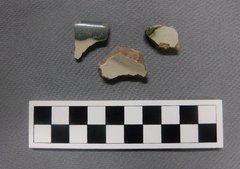Majolica is the general name given to ceramic types that exhibit a tin-glaze enamel glaze. This type of ceramic was a tradition brought to Mexico by the Spanish. It is believed to have been developed in the Mediterranean regions, eventually spreading to Spain during the 11th Century.
The tin enamel is created by adding tin to the lead glaze during the firing process. The tin causes the surface of the ceramic to become opaque, typically in shades of white and cream. Other shades can be created by adding other minerals that cause the tin enamel to become blue, yellow, or sometimes have a green hue. The tin-glazed ceramics are broken down into categories based on colors and decoration styles.
The styles and colors can often be traced to certain regions or potters and can also aid in determining the manufacture date. Most of the majolicas that are encountered at the Alamo and the other Spanish Colonial sites in San Antonio were most likely manufactured in Mexico since 1600s. Today, similar wares are manufactured throughout the world.
One can take a trip today to El Mercado in San Antonio and find a type similar to the blue and white varieties of majolica used during the Colonial Period.
The photograph shows just a few versions that have been found at the Alamo during the current excavations.


